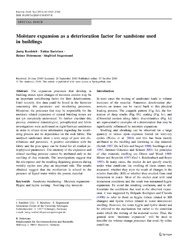Moisture expansion as a deterioration factor for sandstone used in buildings
Zeitschrift: Environmental Earth Sciences, 201063, 7/8: 1545 - 1564
DOI: https://doi.org/10.1007/s12665-010-0767-0
Persistent URL: http://resolver.sub.uni-goettingen.de/purl?gldocs-11858/6790
Persistent URL: http://resolver.sub.uni-goettingen.de/purl?gldocs-11858/6790
Ruedrich, Joerg; Bartelsen, Tobias; Dohrmann, Reiner; Siegesmund, Siegfried, 2010: Moisture expansion as a deterioration factor for sandstone used in buildings. In: Environmental Earth Sciences, Band 63, 7/8: 1545 - 1564, DOI: 10.1007/s12665-010-0767-0.
 |
Dokument öffnen: |
The expansion processes that develop in building stones upon changes of moisture content may be an important contributing factor for their deteriorations. Until recently, few data could be found in the literature concerning this parameter and weathering processes. Moreover, the processes that may be responsible for the moisture related expansion of natural building stones are not yet completely understood. To further elucidate this process, extensive mineralogical, petrophysical and fabric investigations were performed on eight German sandstones in order to obtain more information regarding the weathering process and its dependence on the rock fabric. The analysed sandstones show a wide range of pore size distributions and porosities. A positive correlation with the fabric and the pore space can be found for all studied petrophysical parameters. The intensity of the expansion and related swelling pressure cannot be attributed only to the swelling of clay minerals. The investigations suggest that the micropores and the resulting disjoining pressure during wet/dry cycles also play an important role. The results obtained suggest that the mechanism is related to the presence of liquid water within the porous material.
Statistik:
ZugriffsstatistikSammlung:
- Geologie [933]

